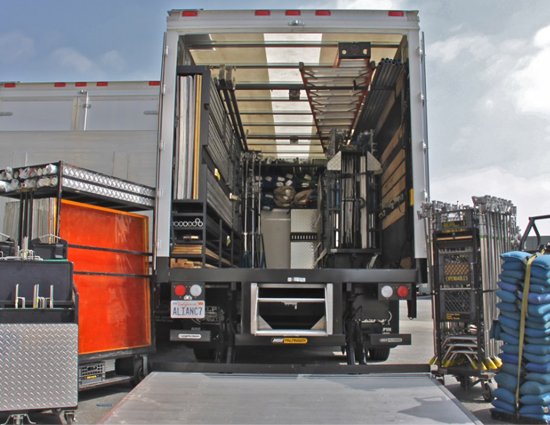All about Grip Trucks
The reason why grip trucks are so important is that they solve problems on the go. Your lighting and camera crew won’t be happier than when they see the addition of a good grip truck on standby.
Andrus Lighting gives optimal packages necessary to give your team the best chance to get the job done at a clear and concise competitive rate to ensure all productions, big and small, can afford to get their hands on this essential package.
What is a Grip Truck?
So what is a grip truck? In short, it is a large truck that carries lighting and grip equipment. This equipment is crucial to a DP and Director’s setup.
What do grip/electric trucks include?
It depends on the package and the size of the truck. But generally, grip trucks will include a range of items such as stands (C-stands, combo stands), overhead frames, apple boxes, sand bags, furniture pads/sound blankets, flags, diffusion, multiple overhead frames, camera dolly, and rigging equipment. The last thing anyone wants is a claim that the right equipment wasn’t available when setting up risky shots.
Overhead Scrims which can be found on grip trucks can soften the light and reduce the intensity of lighting. Flags are essential when looking to block and/or shape light to create shadows. Whereas Silks/diffusion often help soften and spread the light.
Other items most commonly available on a grip truck are ladders, cones, chairs, cables, clips, tarps, solids, clamps, frames, lumber, and all sorts of electrics, power tools, or rigging equipment.
Grip Truck Sizes
Each grip truck will include more or less of the above equipment based on the packages.
Andrus Lighting provides 3 packages:
● 1-2 ton package (most popular)
The three different sizes cover a wide range of usability for any size set you’re working on. 1-2 ton truck is typically used for corporate and smaller commercial productions. 3 ton is usually large corporate to medium commercial. Whereas the 5-ton truck is usually used for larger commercial production. Now match this comparison with the scale of your production, but not necessarily the size of your project. Some productions may only need a 1-2 ton truck depending on the amount of locations, crew, or equipment deemed necessary. Sometimes a small shoot may require a large amount of lighting or equipment based on the style or setup. The more complex or lavish the production, the more likely you’ll need to go all in for the bigger package.
5-Ton Grip Truck
There is no stone unturned when it comes to the Andrus Lighting 5-ton grip truck package. This is pound-for-pound the most comprehensive package a gaffer or key grip, could need. The extra space and sheer amount of equipment is one of the benefits of the 5 ton is having all of the equipment on carts leading to faster setup on set. Check out the link below if you don’t believe us!
3-Ton Grip Truck
The 3-ton grip truck is, shall we say, the middle ground. If you have the full scope of your production and you’re mulling over the size of the package it’s likely the 3 Ton package works best for you. This is because when in doubt at either end of the 5-ton or 1-ton spectrum, it makes sense to just play it safe and stick to somewhere in between. It will give you everything you need in terms of upgrading from a smaller package. But at the same time will be less costly than the high-end package when deliberating over that dreaded budget. There are still plenty of extras included in the Andrus 3-ton package which you can view below:
1-2 Ton Grip Truck
This is perfect for a lot of smaller commercial and corporate projects that just need the essentials. It provides commonly used equipment for small to middle-sized jobs. Standard service of the additions necessary to get you going on a smaller to medium scale production. The vehicle will be a nice bonus for when carrying extra lighting equipment too and is easier to find parking, which we all know can be a stressful obstacle on any film set.




